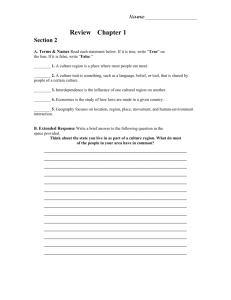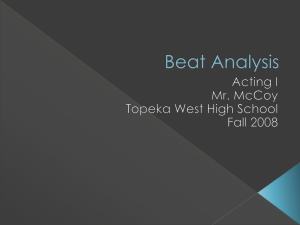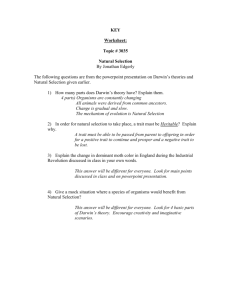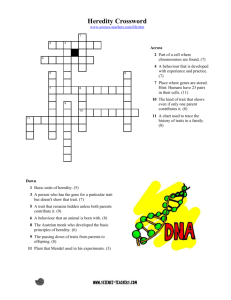Third Grade Social Studies CRCT Review Sheet
advertisement
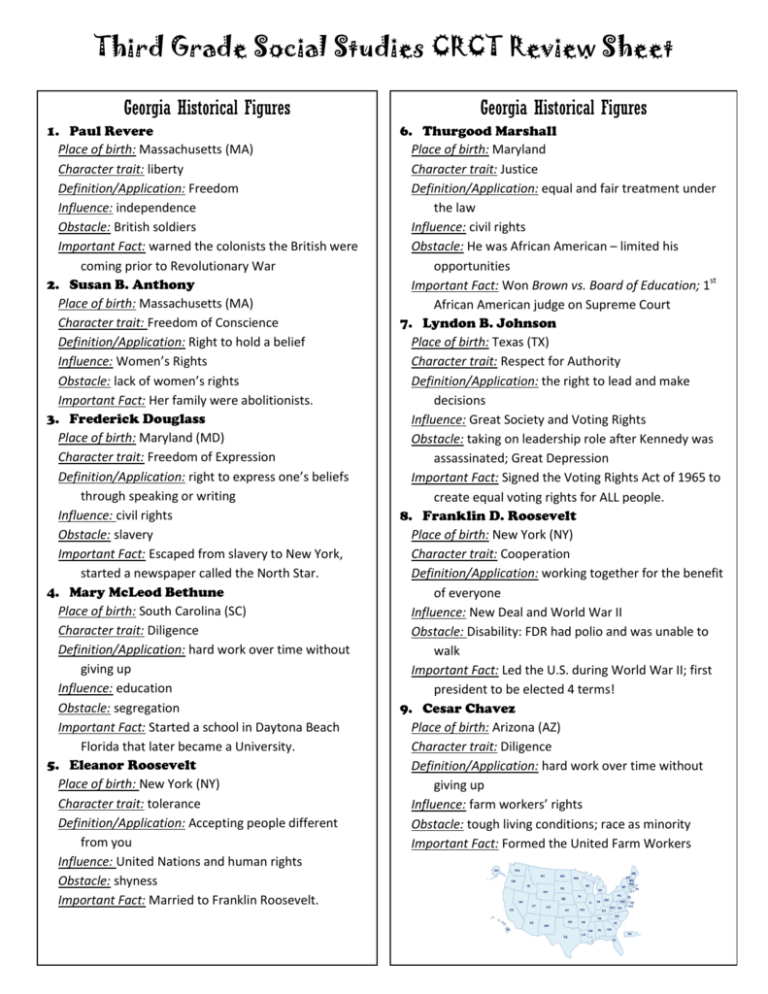
Third Grade Social Studies CRCT Review Sheet Georgia Historical Figures 1. Paul Revere Place of birth: Massachusetts (MA) Character trait: liberty Definition/Application: Freedom Influence: independence Obstacle: British soldiers Important Fact: warned the colonists the British were coming prior to Revolutionary War 2. Susan B. Anthony Place of birth: Massachusetts (MA) Character trait: Freedom of Conscience Definition/Application: Right to hold a belief Influence: Women’s Rights Obstacle: lack of women’s rights Important Fact: Her family were abolitionists. 3. Frederick Douglass Place of birth: Maryland (MD) Character trait: Freedom of Expression Definition/Application: right to express one’s beliefs through speaking or writing Influence: civil rights Obstacle: slavery Important Fact: Escaped from slavery to New York, started a newspaper called the North Star. 4. Mary McLeod Bethune Place of birth: South Carolina (SC) Character trait: Diligence Definition/Application: hard work over time without giving up Influence: education Obstacle: segregation Important Fact: Started a school in Daytona Beach Florida that later became a University. 5. Eleanor Roosevelt Place of birth: New York (NY) Character trait: tolerance Definition/Application: Accepting people different from you Influence: United Nations and human rights Obstacle: shyness Important Fact: Married to Franklin Roosevelt. Georgia Historical Figures 6. Thurgood Marshall Place of birth: Maryland Character trait: Justice Definition/Application: equal and fair treatment under the law Influence: civil rights Obstacle: He was African American – limited his opportunities Important Fact: Won Brown vs. Board of Education; 1st African American judge on Supreme Court 7. Lyndon B. Johnson Place of birth: Texas (TX) Character trait: Respect for Authority Definition/Application: the right to lead and make decisions Influence: Great Society and Voting Rights Obstacle: taking on leadership role after Kennedy was assassinated; Great Depression Important Fact: Signed the Voting Rights Act of 1965 to create equal voting rights for ALL people. 8. Franklin D. Roosevelt Place of birth: New York (NY) Character trait: Cooperation Definition/Application: working together for the benefit of everyone Influence: New Deal and World War II Obstacle: Disability: FDR had polio and was unable to walk Important Fact: Led the U.S. during World War II; first president to be elected 4 terms! 9. Cesar Chavez Place of birth: Arizona (AZ) Character trait: Diligence Definition/Application: hard work over time without giving up Influence: farm workers’ rights Obstacle: tough living conditions; race as minority Important Fact: Formed the United Farm Workers Map Skills * United Sates has many different landforms. Landforms are natural features on Earth’s surface: plains, mountains, rivers, lakes, valleys and hills are natural landforms. Students should know 2 major mountain ranges and 5 major rivers of the United States: Mountain Ranges Major U.S. Rivers P = Rocky Mountains Q = Appalachian Mountains U = Atlantic Ocean W = Pacific Ocean V = Gulf of Mexico A = Colorado River B = Rio Grande E = Mississippi River C = Ohio River D = Hudson River Colorado River – flows out of Rocky Mountains. Mississippi River – longest river in the U.S. Rocky Mountains – the highest mountain range in the United States Lines of latitude Lines of Longitude Equator Prime Meridian imaginary lines around the earth that measure distances NORTH or SOUTH of the equator imaginary lines around the earth that measure distances EAST or WEST of the equator imaginary line around middle of globe that divides it in half. imaginary line that separates the East and the West side of the Earth LINES RUN FROM EAST TO WEST LINES RUN FROM NORTH TO SOUTH Government: 1. What kind of government does the United States have? Representative Democracy 2. A constitution is a plan for how government should run. 3. The constitution created and described the roles of each branch of our national government? 4. Where does the president work and live? The White House: Washington, DC. 5. Where do government leaders in the state of Georgia work? The capital - Atlanta Three Branches and Levels of Government * You must know the 3 branches of government, 3 levels of government and what they do! Three LEVELS of Government Local State National City – Cedartown, GA State - Georgia Country – United States Three Branches of Government Legislative Judicial Executive MAKES THE LAWS EXPLAINS THE LAWS ENFORCES THE LAWS Local: City Commissioners Local – Polk Superior Court State: General Assembly: State: GEORGIA Supreme Court Local – City Manager (Bill Fann) State: Governor (Nathan Deal) National: Congress 2 parts: Senate and House of Representatives National: SUPREME COURT: 9 members called JUSTICES National: President (Barack Obama) Government Services: * You need to know the government services that are provided at each level of government! What is a government service? Services provided by the government. What are taxes? A fee that citizens pay to the government. Examples: Local Government Services Teachers Librarians Police officers Firefighters State Government Services State Parks State Highways State Patrol Officers National Government Services Post Offices Military National Parks and Forests Greece: • • • The student should be able to locate GREECE on a map. Z = Greece Hint to remember ~ Greece is located to the right of Italy (Y on this map) which is shaped like a boot! • • • • • • Greece is a group of islands and a peninsula in the Mediterranean Sea. • A peninsula is land that is surrounded by water on three sides. • Athens was the first city-state to have its citizens participate in government. • A citizen is a person who lives in an area and is loyal to that area. The word democracy is a Greek word that means, “Rule by the people.” The way people ruled was by voting. Voting is making an official choice. A Direct Democracy: A government in which people vote to make their own rules and laws. This is the type of government GREECE had. A Representative Democracy: A government in which people vote for representatives. The representatives make rules and laws that govern themselves and the people. This is the type of government U.S. has. The ancient Greeks invented three types of columns. Today, these column designs are used on buildings all over the world. THIS IS A BIG INFLUENCE FOR AMERICA!! Economics: Resources Needs are things you must have to live. Wants are things you do not need but would like to have. Goods are all the things people make or use. Services are jobs that people do for others. A resource is something used to make goods and services. Natural resources are things from earth that people can use. Human resources are people working to make goods and services. Capital resources, resources that are used to make goods and services. Taxes People pay income tax, a tax on their income. Property tax is paid on the value of someone’s property, such as their land or house. Sales tax is the tax added to the cost of what you buy. TRADE Producers make goods or perform services. Consumers buy goods or services. Supply is how much of a good can be had. All goods have a limited supply. Demand is how much people want to buy a good. Scarcity is when there is not enough supply of a good. Trade is an exchange. An import is something that a country buys from another country. An export is something that a country sells to another country. Currency is the money used in a country. Canada China Japan Mexico U.S. Dollar Yuan Yen Peso Dollar $ ¥ ¥ $ $ Spending/Saving An opportunity cost is what people have to give up in order to get what they most want. EXAMPLE: You are saving to buy a bicycle that costs $100.00. You decide not to buy a toy that costs $25.00. The opportunity cost is $25.00 – for the toy you gave up. A budget is a plan for using money. Interest is the money the bank pays when you store your money there. Deposits mean the money people put into a bank. A withdrawal is the money a person withdraws, or takes out of the bank.



